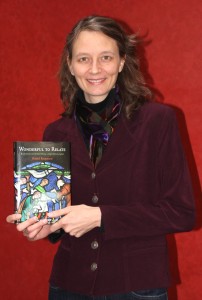 TORONTO, December 21, 2010 − For more than a century, English monks bent over manuscripts scratching out by hand thousands of stories about miracles performed posthumously by saints, many in Canterbury cathedral. Often, all it took was a prayer to a saint or a visit to a saint's tomb for a miracle to take place, and if it was the late 11th or early 12th century, that miracle may well have been written down by a monk.
TORONTO, December 21, 2010 − For more than a century, English monks bent over manuscripts scratching out by hand thousands of stories about miracles performed posthumously by saints, many in Canterbury cathedral. Often, all it took was a prayer to a saint or a visit to a saint's tomb for a miracle to take place, and if it was the late 11th or early 12th century, that miracle may well have been written down by a monk.
After all, who doesn't like a good miracle? As York history Professor Rachel Koopmans, author of the recently published Wonderful to Relate: Miracle Stories and Miracle Collecting in High Medieval England, says, "miracle stories almost always have happy endings."
Although the medieval period did not have a monopoly on miracles – Koopmans says people today believe they continue to occur – there was a specific period of time in which medieval writers fervently recorded them in Latin. The most famous of these are the Thomas Becket miracles. This is what Koopmans calls a "fad" for miracle collecting that lasted about 150 years.
"I'm trying to tell…the story of this big burst," says Koopmans. To do so, she surveyed more than 75 collections, examining how they were generated, circulated and replicated. In the first two chapters of Wonderful to Relate (University of Pennsylvania Press, 2010), she looks at the oral circulation and tradition of these miracle stories and how their telling could generate further miracles, then turns to how this mania over recording miracles came about.
Miracle preserving reached its peak just after the murder of Becket in Canterbury cathedral in 1170, following a disagreement with King Henry II. After King Henry II and his men left the area, the monks allowed pilgrims to visit Becket's tomb. "Afterward, people reported that they were healed by Becket's power, and soon floods of people were coming to Canterbury," says Koopmans. "In 1171, a year or so after Becket's death, monks started collecting these stories. They continued collecting for about five or six years."
Most of the Becket miracles were collected by only two monks – William of Canterbury and Benedict of Peterborough. "They certainly heard many more stories than they actually recorded. Reading the collections, you get a sense of an incredible mob scene and huge excitement in Canterbury cathedral in those years after Becket's murder."
There were tales of miracles involving blind people being able to see, pregnant women having difficulty giving birth but still delivering healthy infants, accidents in which people avoided death, insane people being cured and even animals, such as sick cows, being healed. Even King Henry eventually visited Becket's tomb, apologizing and recognizing him as a miracle-working saint.
 "There is a period in which dozens of English monks wrote down thousands of miracle stories and then that impulse to record miracle stories mostly disappears," says Koopmans. "Why would 12th-century monks put in all that effort to record so many very personal and often very earthy stories of saintly intervention? That question inspired my book."
"There is a period in which dozens of English monks wrote down thousands of miracle stories and then that impulse to record miracle stories mostly disappears," says Koopmans. "Why would 12th-century monks put in all that effort to record so many very personal and often very earthy stories of saintly intervention? That question inspired my book."
These miracles weren't preserved for the average person to read; they were never translated into Middle English or French. The oral tradition of circulation was what continued to be most influential and carried more propagandistic power among the pilgrims than anything written. But these miracle collections provide a rich look into the personal lives of pilgrims, how they lived and what they struggled with during that time.
By the early 13th century, the miracle recording had waned and the window that allowed this intimate glimpse into the lives of medieval pilgrims was closed. This was around the time that formalized canonization procedures began. In 1220, Becket was moved to a new shrine where he was surrounded by stained-glass miracle windows, depicting dozens the miracles he performed posthumously. It came at a time when the "enthusiasm for miracle collecting that had gripped English monks and canons since the late 11th century was evaporating," says Koopmans. But just because miracles ceased to be recorded, doesn't mean they didn't continue to happen.
Koopmans is working on another book about the Becket miracle windows.
York University is the leading interdisciplinary research and teaching university in Canada. York offers a modern, academic experience at the undergraduate and graduate level in Toronto, Canada’s most international city. The third largest university in the country, York is host to a dynamic academic community of 50,000 students and 7,000 faculty and staff, as well as 200,000 alumni worldwide. York’s 10 Faculties and 28 research centres conduct ambitious, groundbreaking research that is interdisciplinary, cutting across traditional academic boundaries. This distinctive and collaborative approach is preparing students for the future and bringing fresh insights and solutions to real-world challenges. York University is an autonomous, not-for-profit corporation.
Media Contact:
Janice Walls, Media Relations, York University, 416 736 2100 x22101 / wallsj@yorku.ca

